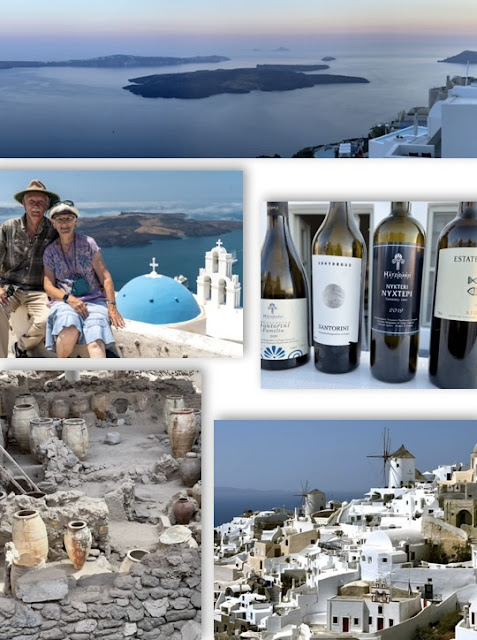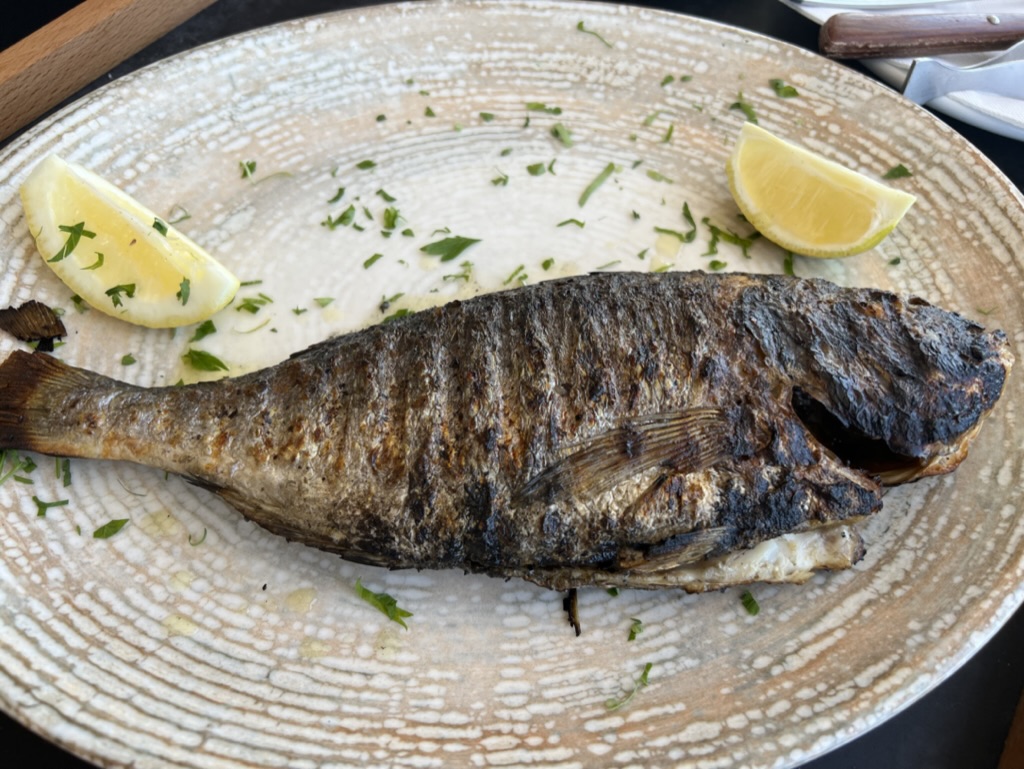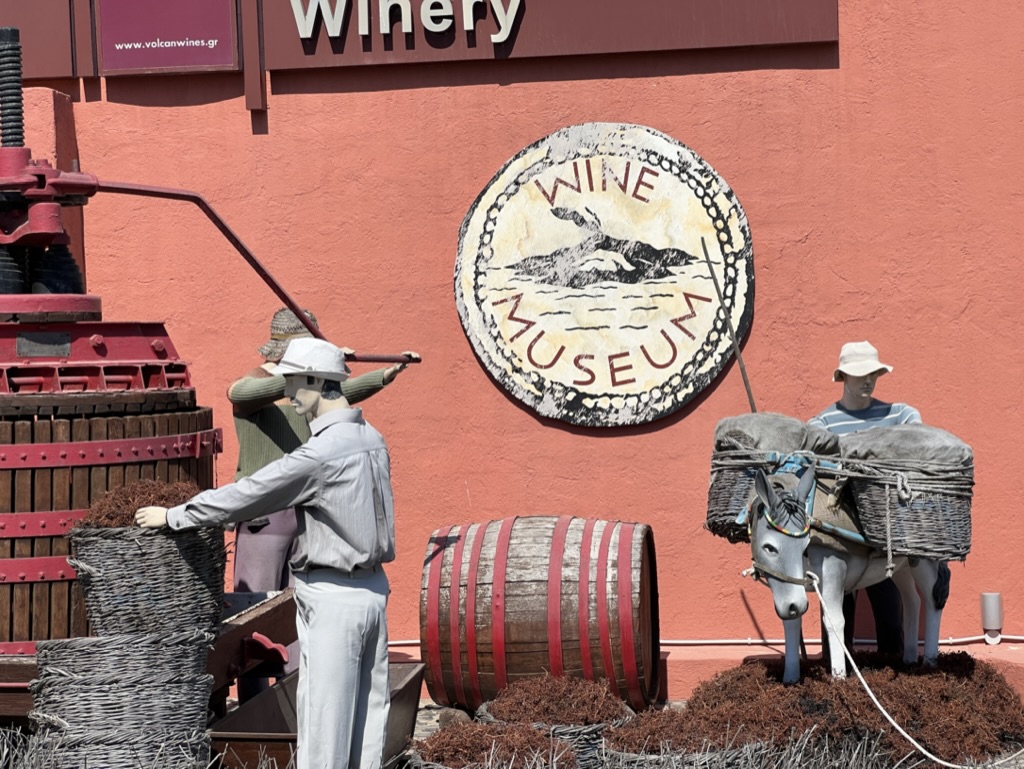Santorini is simply gorgeous. Its mesmerizing beauty is thanks, in part, to a massive volcanic eruption around 1610 BC that destroyed the early settlements and reshaped the island. It now curves around roughly 2/3 of the caldera. Over the centuries, numerous small eruptions have continued resulting in the two small islands inside the caldera...as if designed for anchoring spots for the sunset cruises.
In cliffside villages, white houses with blue window trim adorn the clifftops of the caldera. Lovely churches and the occasional remains of a windmill add to the beauty. These amazing views transform to other amazing views at sunset. and morning haze creates yet another spin on the beauty. Paths along the hillsides connect the villages. Roads are mostly limited to the hilltops and inner parts of the island.
And as an added appeal to us, much of the non-touristy area of Santorini is covered with vineyards, mainly planted with Assyrtiko grapes. These make a fine wine, we'll talk about that later.
A lesser known appeal of Santorini is that it offers a chance to explore some of the oldest ruins of Greece, in fact, of probably anywhere. Akrotiri, a Minoan city of 30,000 inhabitants at its peak, was first settled in 5C BC and destroyed by the eruption in 16C BC. Neighboring ancient Thera was settled even earlier but only Roman ruins are left to explore...still impressive.
What does one do on Santorini? Well there is always lounging in your cliffside rental, soaking in your hot tub and in the beauty surrounding you. But if you'd like more variety, you can:
- explore the cute towns with their great selection of shops and restaurants along with endless enchanting views
- seek out the perfect spot for sunset views from well-situated restaurants, a sailboat or anywhere you happen to be that includes a view of the cliff-sides and the sea
- sample the selection from a few of the many fine wineries
- checkout the local landmarks including churches, a lighthouse, the Red Beach, the White Beach and the Black beach
- visit the ruins and the museums
It was plenty to keep us busy for 6 days, even after having visited for a week previously (in 2013).
Arriving at our rental we were captivated by the breathtaking view, We knew we'd have to share the view with passer-byes but discovered the view was so special that it attracts wedding photo shoots and even glamour shots with flowing colorful dresses.
First things first. We needed local phone service to support out on-line habit...really to support our use of google maps to get around and WhatsApps to keep in touch with various services along our way. We headed to the Vodafone office with a stop for lunch at the Aegean Restaurant, visible from our rental, and recommended by our rental agent. Great seafood. Good enough that we returned later with Dave & Shelly.
As we continued along the cliffside walk to the Vodafone office, we passed by the Da Costa restaurant where we had enjoyed an unusually specular sunset on our trip in 2013.
Searching for a sunset is a popular pass time here. Since most of the restaurants, bars, and accommodations face west, it is more difficult to choose between options than to find a fine sunset view. And evening sunset cruises add another option for sunsets, as well as
some interesting shots of the coastline.
On our way to the southern tip of the island we stopped at Santos for our first wine tasting. They offer a nice selection of nibbles to complement the wines.
Before visiting Ancient Akrotiri, we stopped to look at the nearby lighthouse and to checkout the view back to our apartment.
 |
| Akrotiri ancient & modern. Top right photo shows a view back to our rental at the top left. Bottom photo shows a triangular town square bordered by a 2 story housing complex. |
This was the stop that opened our eyes. We knew we would be exploring ancient sites. But we hadn't comprehended just how ancient. The earliest evidence for human habitation of Akrotiri seems to be as early as the fifth millennium BC (5000 BC to 4001 BC). By the end of the third millennium, it had developed to an estimated population of 30,000. Later (16C) an eruption buried the city under a thick blanket of ash and pumice, resulting in a time capsule for discovery 35 centuries later.
We went to The Wine Bar in Imerovigli for a tasting and some sunset snacks. We enjoyed the Mediterranean Nachos: toast with feta cheese, fresh & sundried tomato, green pepper, and onion. We concluded our evening with some bubbles and a nice sunset.
A stop in Oia, at the northern tip of Santorini is a must. While strolling and shopping our way along through the lanes and shops (some of the best shops on the island), we paused at Flora Comfort Cuisine for a quick bite. The tomato keftedes (fried tomato balls) were especially good.
Our wandering brought us to the far end of town and to the view point featuring iconic Santorini architecture, windmills and all.
Along the way we spotted some riders on mules ascending from the Amoudi fishing village, a strenuous 500 foot climb.
For one day we had scheduled an afternoon wine and food pairing at Sigalas. We decided to fill in the morning with a visit to Ancient Thera. The city was founded in the 9C BC and continued to be inhabited until the early Byzantine period (3C AD). The preserved ruins are from the Roman phase of the city. It is located on Mesa Vouno, 396 m/1300 ft. above sea level. Note the road leading up to the site (top left photo). It is a delightful place but we had to cut the exploration a bit short in order to make it to our tasting.
Lunch at Sigalas proved to be a very special wine tasting and food pairing. It started with an informative walk through the vineyards which included details about the way Assyrtiko vines are maintained (the vines are wrapped to fit in a circular protective hole in the ground) and how the red varieties do better in the more traditional upright style.
The tasting was extra special with 3 styles of Assyrtiko, a Mavrotragano (red) and a Vin Santo with 5 perfectly matched gourmet food courses from salad through seafood, meat, and dessert. Each of the wines was great. This was, hands down, the most perfect food and wine pairing we have ever experienced.
For our final day on the island, we visited the Museum of Prehistoric Thera, which has a significant collection of items found at the Akrotiri site.
There were the traditional assortment of ceramic vessels (ewers, amphoras, urns, basins), elaborate wall frescoes, scale models of the town, and a precious Golden figurine of an Ibex. Some of the simpler frescoes show rosettes, geometric work, and even monkeys. More elaborate frescoes depict adolescent fishermen, as well as adventures and explorations of early Aegean seafarers.
Heading back to our rental, we checked out a couple churches, the Orthodox Metropolitan Cathedral (framed with giant arches) and the Catholic Cathedral (baroque structure of blue-gray and cream with touches of peach). We noted a painting of Mexico's favorite lady and saint: Guadalupe. We strolled on through the shops and restaurants along the cliffside. One shop caught our eye...with a very cool cat T-Shirt.
After some photo stops we chose Onar for another Assyrtiko and seafood lunch.
Later in the afternoon we drove to the Koutsoyannopoulos Wine Museum (say that 3 times fast...or even try saying it once...) for some history of the industry here on Santorini. And of course, for another wine tasting...
Here are some facts about Red Wine that we learned in one exhibit. We have the back up details in a photo but it is too busy to post. Read it and you'll see how healthy it can be. But they forgot to mention a key benefit: Many wines (even most wines if you are selective) taste good!
Red Wine: 10 Unbelievable Benefits
- It helps you lose weight
- It strengthens the brain
- It cures gum disease
- It fights fatigue
- It releases endorphins
- It cleans the palette
- It reduces cholesterol
- It is perfect for the heart
- It reduces the risk of cancer
- It helps in the fight against urinary infections
Continuing on we found the following advice:
Of course we couldn't forget that one last Assyrtiko (and more) tasting.
And in closing, we'd like to share some of the churches we encountered on our wandering around Santorini. Note: This is a very small portion of what we saw, and an extremely small portion of what there are.




















No comments:
Post a Comment